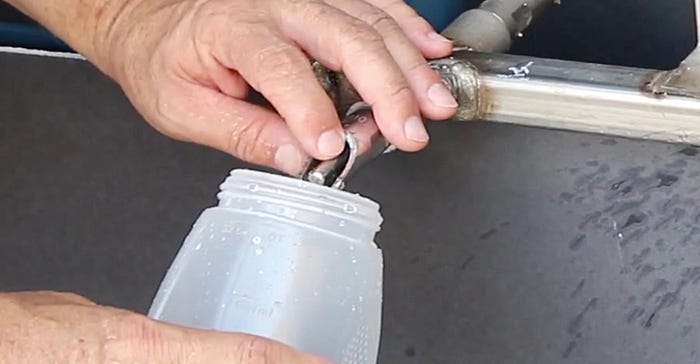Making the decision that improving water quality at a production site is the first step in any water treatment program.

Sponsored Content
The next immediate step needs to be determining exactly what the current water the animals are drinking contains. Several considerations must be taken when sampling the site. The first is the sample must be the best representation of the water coming in to the facility. That means taking it prior to any treatment or other interactions that may interfere with the analysis. Take samples as close to the well as possible, and if multiple water sources are used, get the sample from the best blended sample possible. In most cases, the raw water sample will come from a pressure tank at the beginning of the barn. When sampling make sure to use clean hands, a clean container, and not to contaminate the sample with your hands or anything on the sampling spigot. Clean the spigot prior to taking the sample and do not touch the sample container to the spigot. Fill the container all the way to the top, and then fill the lid. A sample container needs to have as little air in it as possible, as air in the sample can alter pH levels and change the chemical composition of some minerals.

Take a second sample directly from the pig’s drinking source such as the nipples or troughs
Next, realize that a single source sample is insufficient. It does not tell the producer what the animals are actually drinking, only what the source is before the water lines may alter it. Therefore, a second sample must be taken. Select the “worst case scenario” for the second sample. You want what the animals are actually drinking, and this sample is arguably more important than the raw water as it’s what is actually going to the animal. Again, follow proper sampling procedures, but mimic the animal’s drinking habit. If the drinker is a nipple, trigger the drinker with the bottle to fill it. If it is a trough, dunk the bottle in the trough, if it is a wet/dry feeder, get the sample from the actual drinker, not a hose that is ‘more convenient’. Again, the key is to see what the animal gets on a regular basis. Do not be concerned on how bad the sample will come back. After all, the sample is being taken because the decision has been made that production gains could come from altering what the animals drink. Do try to sample on a day without added variables (medication, nutritionals in the water, etc), but if an existing treatment system is running, leave it on. Whoever analyzes the samples should be able to determine that a program is being run, but also if it is effective.
After sampling, send the water to a reputable lab that the producer trusts. If biological count data is desired, ice the samples and overnight or hand deliver them (preferably not on a Friday). Most producers do not need actual numbers, just a presence or absence, so if counts are not required, standard shipping is fine. If the producer wants to see if there is biofilm build up in the lines, a swab of the water line walls may be in order as well.
Indicate that the sample is for livestock, and ask the lab to run a traditional livestock suitability panel. This will likely include pH, calcium, iron, manganese, magnesium, total dissolved solids, total suspended solids, nitrates, sulfates, chlorine, and sodium. Extra minerals like copper, phosphorus, potassium, etc may also be included, but the first set of analytes is the most important. Also indicate if biological samples are important to the producer, and if so have them run. Typically E.Coli and total coliform are standard, but biological activity can be inferred by comparing the samples on pH, sulfate, and nitrate.
Lastly, most labs will provide sample bottles ahead of time for their specific laboratory. If the sampler does not have a bottle, 16 or 20-ounce water bottles are easily found at convenience stores and serve as perfect sample containers as they are clean and sterile prior to opening. To use them, or any other sample container, do not open them until in the facility and ready to sample. Pour them out immediately prior to sampling, and do not contaminate them by drinking the bottle empty first. Take the samples, cap them, wipe them dry, then identify them in some way for the lab (like numbering the lid or writing the sample name and location on some tape on the bottle). Tape the lid if you would like for extra security, then pack it in a mailing box with plenty of cushion for the ride in the mail. Add a sheet describing the samples in the mailing box as well, and send them off depending on the needs of the sample (overnight or standard).
Once the results come back (a standard list of numbers), have a livestock water professional analyze the numbers and explain not only what the numbers mean, but how any shifts in the levels tells the producer what’s happening in the water lines. Once this sampling and analysis takes place, the producer can then determine what the proper treatment at their site may be, while understanding their goals through water treatment. With this analysis, rather than trying to fit their site into a treatment system that may not be the best for their issues, the producer and water treatment supplier can create a custom system for their site that meets their expectations.
About the Author(s)
You May Also Like



